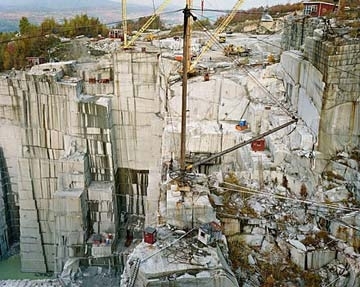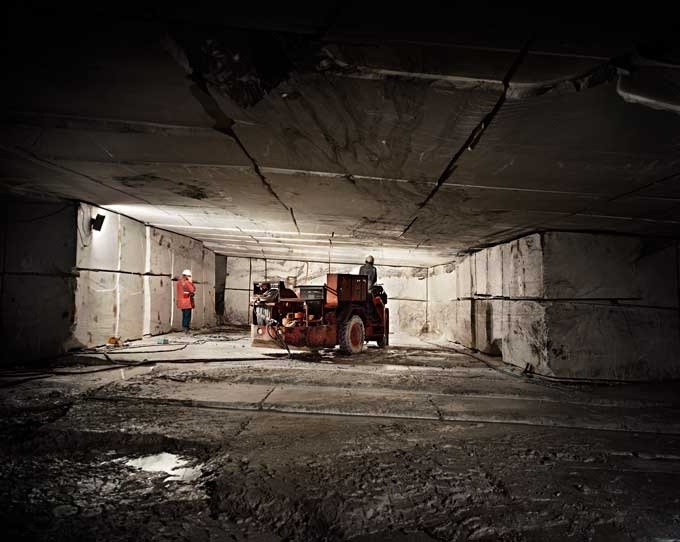Nature Transformed: Edward Burtynsky's Vermont Quarry Photographs in Context
–

Edward Burtynsky (Canadian, b. 1955), Rock of Ages No. 19, Granite Section, Rock of Ages Quarry, Barre, Vermont, 1991, chromogenic color print on paper, 40 x 50 inches. Collection of Middlebury College Museum of Art, purchase with funds provided by the Walter Cerf Art Acquisition Fund. 2008.034
Nature Transformed is an exhibition which takes as its starting point a remarkable series of photographs by pioneering, internationally celebrated artist Edward Burtynsky. The show, which was previously mounted at the Hood Museum of Art at Dartmouth College, will be on view through June 9. The closing date has been extended in conjunction with Burtynsky’s designation as an honorary degree recipient at Middlebury’s 2013 commencement proceedings.
Burtynsky’s now signature pursuit of conceptual subjects—from oil extraction in the United States and in Azerbaijan to shipbreaking in Bangladesh—started in 1991 in the granite quarries of Barre, Vermont. One hundred years before Burtynsky encountered Vermont’s quarries, stoneworkers emigrated here primarily from the ancient quarrying town of Carrara, Italy, as artists and artisans to contribute their expertise to an industry in the throes of expansion. They brought along with them a love for opera, political activism, and strong values that made their assimilation into American society relatively easy. Nature Transformed considers a selection of Burtynsky’s monumental photographs—seven of which Burtynsky has only recently shown for the first time, including two he took in the little-known but extensive underground quarries in Danby, Vermont—within this context of Vermont’s social and cultural history as well as the much longer history of the geological formation of northern New England and its marble and granite deposits.

Edward Burtynsky (Canadian, born 1955), Rock of Ages #4, Abandoned Section, Adam-Pirie Quarry, Barre, Vermont, 1991, digital chromogenic color print. Photograph courtesy Howard Greenberg & Bryce Wolkowitz, New York / Nicholas Metivier, Toronto.
Interestingly, Burtynsky made the reverse journey of those Italian immigrants with his Quarries project—first he discovered the quarries in Vermont and then he was pointed toward Carrara by a quarry owner. This was in turn the artist’s first international trip for his work and represents the genesis of the global exploration of nature and industry for which he is renowned today. Nature Transformed showcases several of his photographs from Carrara as well, signaling the geographical aspect of this story of human migration.
According to Michael Taylor, the Director of the Hood Museum of Art, “Burtynsky’s powerful artistic vision of the interaction between humans and the environment is the guiding force behind the exhibition’s conception.” In the exhibition catalogue, co-curator Pieter Broucke writes, “Burtynsky subtly combines his instinctive appreciation for the powerful formal aspects of the quarries with his growing subjective awareness of the devastation that large-scale industrial quarrying has wrought on the landscape. The detritus of abandoned equipment, derricks, sheds, stairs, cables, tanks, discarded blocks and stones, and other litter becomes increasingly prominent in the photographs. The artist’s initial impression of the monumental voids as formal presences inserted within the landscape gradually includes recognition of the quarries as ecological wounds inflicted upon the landscape.”
Searching out these monumental voids was indeed the idea that drove Burtynsky to Vermont in the first place, after he had spent time photographing ore mines. In an interview for the exhibition catalogue, he recalls, “I thought of our cities, which are made from stone that is kept intact …The type of excavation that resulted from dimensional stone seemed to indicate that there had to be a more orderly removal of the materials than at an ore mine. The idea I had was that I might be able to find the reverse of a skyscraper somewhere, an inverted pyramid where the blocks were being removed. So I pursued that.” The resulting images on display in Nature Transformed are often breathtaking in their scale and visual power.

Edward Burtynsky (Canadian, born 1955), Danby Marble Quarry #2, Underground Quarry, Danby, Vermont, 1995, digital chromogenic color print. Courtesy of the artist.
Edward Burtynsky is known as one of Canada’s most respected photographers. His remarkable photographic depictions of global industrial landscapes are included in the collections of over fifty major museums around the world, including the National Gallery of Canada, the Bibliothèque Nationale in Paris, the Museum of Modern Art and the Guggenheim Museum in New York, the Reina Sofia Museum, Madrid, and the Los Angeles County Museum of Art in California. Burtynsky links his early exposure to the sites and images of the General Motors plant in his hometown to the development of his photographic work. His imagery explores the intricate link between industry and nature, combining the raw elements of mining, quarrying, manufacturing, shipping, oil production, and recycling into eloquent, highly expressive visions that find beauty and humanity in the most unlikely of places.
Burtynsky will give an artist’s talk on Thursday, March 14 at 4:30 p.m. in Dana Auditorium on Rte. 125 on the Middlebury campus. At the celebratory opening for the exhibit on Tuesday, February 12 at 4:30 p.m. in room 221 of the Mahaney Center for the Arts, co-curators Juliette Bianco, Assistant Director, Hood Museum of Art, Dartmouth, and Pieter Broucke, Professor of History of Art and Architecture and Director of the Arts, Middlebury, will discuss the artist’s career and the process of organizing the exhibition. Other events associated with the exhibit will be listed on the museum’s website at museum.middlebury.edu. Follow up: if you missed Burtynsky’s March 14 lecture you can now watch it in its entirety
.
Nature Transformed: Edward Burtynsky’s Vermont Quarry Photographs in Context was organized by the Hood Museum of Art and generously supported by Raphael and Jane Bernstein / Parnassus Foundation, Laurie Jean Weil D.V.M. in honor of her parents, Jean and Bucks Weil, Dartmouth Class of 1935, the Marie-Louise and Samuel R. Rosenthal Fund, and the Ray Winfield Smith 1918 Fund. At Middlebury it is supported by the Christian A. Johnson Memorial Fund and the Friends of the Art Museum.
Did you miss Kirsten Hoving’s March 5 lecture “Digging Deep: Edward Burtynsky’s Vermont Quarry Photographs”? Watch a recording of the entire lecture
.
Interested in bringing a group to see Nature Transformed? Click here to schedule a guided tour of the exhibit.

